
Paper & Co. in a playful mood on Saturday afternoon
FOXHUNTING is on hiatus for now while the deer hunters are abroad in the countryside, and that gave us a chance to check in at the Iroquois kennels to see how the puppies are doing.
Paper, of course, has been out hunting now and is gradually maturing into an adult pack member. He’s had important lessons all summer and fall, and now the real education starts on the hunt field. There, he has to confront new situations and work professionally with the hunting pack. I guess to put it in human terms, he’s getting his university degree, and by next year he should be a full-time contributing member of the working world.
But what about our youngest puppies, Baffle’s litter and Dragonfly’s huge son Driver? They’re still in elementary school, but the lessons they’re learning now are critical to their future development.
These puppies were born in the spring, and for the last couple of months they’ve been getting their first exposure to working in a group, to pack manners, and to coming when called, Iroquois kennel manager Michael Edwards explained to us on Saturday.
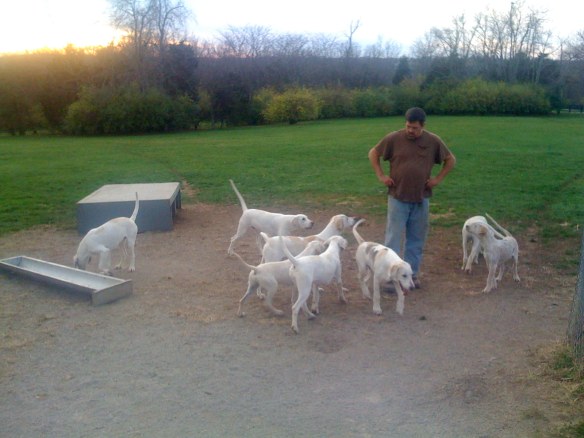
Room to roam: all the hounds--puppies, current working pack members, and retirees--get plenty of free exercise in the two-acre field adjacent to the kennel
After breakfast each day, the 10 young puppies spend about three hours out in the kennel’s two-acre exercise field, one of the best tools the Iroquois staff has for the young hounds’ education.
“They stay out here while we’re getting stuff done in the kennel, and they play and play,” Michael said. “I try to get them out twice a day, once at the end of the day, too, so that they get four to five hours outside.
“Right now, the girls in this litter seem a little more rebellious than the boys,” Michael said of Baffle’s puppies. “The two bigger girls, Bangle and Bandstand, they’ll be the ones that won’t want to go in their kennel. But they’re all very lovable and want attention all the time.”
Assistant kennel manager Alan Foy (seen in the photo above with Baffle’s puppies) has also been working with the youngsters to start developing their sense of pack identity and cooperation.
“Alan’s been taking them out back here, just trying to teach them to stick together and respond when he calls them, and they’ve done really well at that,” Michael said, adding that it’s too early for most of the puppies to have learned their individual names yet. The kennel staff is trying to learn the puppies’ names, too! Many of them look so similar it can be hard to distinguish them, with a few exceptions. Bagshot is the woolly male of the litter; Bashful and Banknote are easy to pick out because they are the two smallest; and Driver, well, he’ll always stand out in a crowd due to his size and dark coloring.
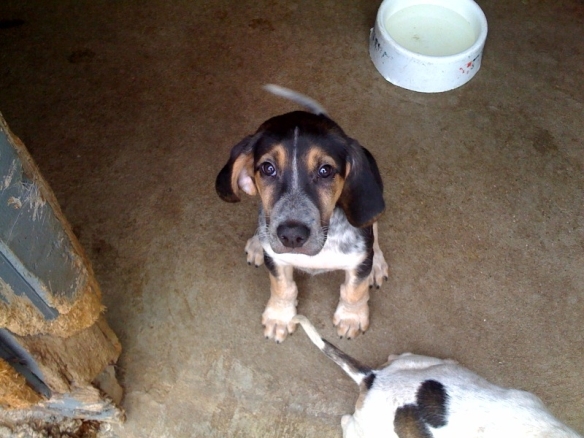
Driver back in July.

Driver today with kennel manager Michael Edwards. A VERY big difference!
“Driver is the biggest baby out here,” Michael said, meaning both the biggest baby and the biggest baby. Recently, Michael set a five-gallon bucket out in the kennel yard, spooking Driver.
“He would not come out here on this concrete while that bucket was sitting there,” Michael said. “I had to get it and move it all the way out by the far gate before he would even come in here, and even then he came in looking at it real carefully. So we’re going to do something we did that worked well with the ST litter (Stam, Stax, Star, Stanza, etc., born in 2007). We’re going to put a windsock in their kennel, something that’s moving all the time so they get used to it. It made a big difference with them.”
In addition to their mini-houndwalks around the property, the puppies also have ventured farther afield with Iroquois joint-Master Jerry Miller and huntsman Lilla Mason. On those, they rode in the hound truck to the old point-to-point course, the same place the older hounds have their early summer walks and pond exercise. Like the older hounds, the puppies got to practice sticking together in a wide open space–their first formal exposure to that critical lesson in the company of the people who will actually hunt them someday.
“All that is important,” Michael said, “because they’re learning how to be a pack.”
The hunt and kennel staff have found it’s useful to start building the pack sense early with puppies.
“With the PA litter (including Panda, Parish, Parody, etc., born in 2005), Lilla and I would take them all through the area together,” Michael said. “By the time we incorporated them into the pack, they already had an idea what was going on, so they just blended right in.”
The puppies don’t yet have the attention span of the older hounds, but already they are focusing on people when they are out on walk, said Alan.
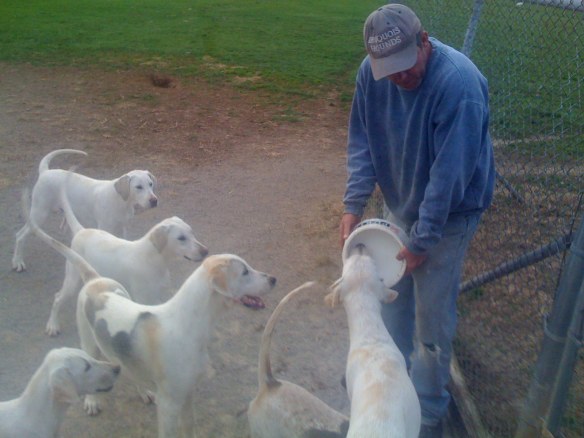
Baffle's litter, shown here with Michael, seem all grown up at seven months of age, but their lessons are just beginning. "I'd say they're like teenagers now," kennel manager Michael Edwards says. "They're just kind of lanky, but they're getting well-balanced."
In the case of Baffle’s puppies, it helps that they are part of a nine-hound litter–a ready-made pack, in a way. For Driver, a singleton, it was especially important that he learn group dynamics as early as possible.
“He lets the little girls chew on his ears,” Alan said. “He’s just a big, goofy puppy. But he’s fit in really well. I agree with Michael that he’s a little passive in the group, but I think it’s because when we first mixed him in with the other puppies he was so much bigger than they were. Now, he’s not quite as much bigger. Barwick and Backfire are getting pretty close to him in size. I think he knew he was bigger and couldn’t play as rough.”
“That all started when they were all at the lower kennel,” Michael said. “He was so much bigger at first that I monitored him closely. If he would be rough, I’d kind of get on him about it and growl at him.”
That lesson seems to have stuck. As Driver romped around with Baffle’s puppies, he was a perfect gentleman with his smaller playmates.
“One of the reasons we wanted to get him in with a group early was because an only child can sometimes have some trouble integrating,” Michael said. “When they’re on their own too long, I think they don’t get socialized with the pack. They don’t learn pack manners and how to respect other hounds. That’s why it was important to get Driver in with the other puppies as soon as we could, especially as big as he is. The longer we waited, the harder it would have been for him to understand that he is part of a pack.”
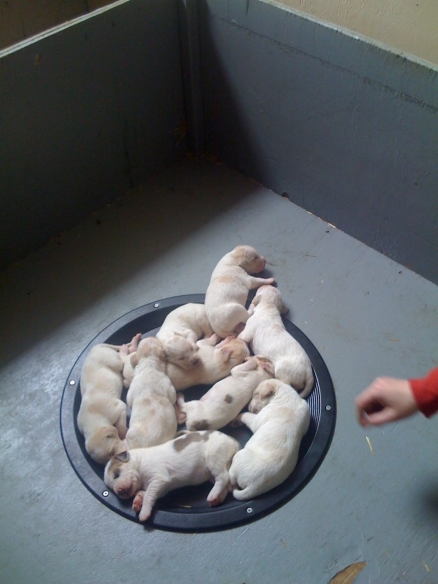
Baffle's litter in April.
“They learn how to be hounds from each other,” Alan said.
The next step, Michael said, is to start occasionally introducing older hounds to the puppies. Paper was one candidate, but evidently he felt pretty strongly that, having moved up with the big dogs in the pack, he was now too important to deal with the little kids anymore.
“He didn’t want any part of those puppies,” Michael said. “He jumped up on top of a bench and growled about it. I thought, being as young as he was, he’d adjust to it pretty quickly, but no, thank you. On the other hand, Panda went out there with them and loved it.”
“She educated them,” Alan said. “She didn’t get aggressive with them, but she let them know when they went too far and she let them know she didn’t want all of them piling on her at once. If they did that, she’d run away and hop up on the bench, and they couldn’t get up there with her. Then she’d wait until they scattered. Then she’d jump down again and play with one or two of them until all of them would pile on her again. She trained them in her way, which was very gentle.”
“Introducing older hounds to them out in that paddock is where I think they really start to learn about having manners toward other hounds,” said Michael. “I think they learn a lot out here in this field with each other, just about how to be a pack. Look at these guys out here right now. They’ve been running and playing for almost an hour. They’ll play to the point that somebody gets a little grumpy and growls, and then they’ll stop. These guys will say, ‘That’s enough,’ and it doesn’t escalate. Then they’ll play again.”
“Nobody knows more about being a hound dog than a hound dog,” Alan said. “We can let them know what’s acceptable and what’s not acceptable. But those hounds know even better how to tell each other what’s acceptable and what isn’t, and they know how to tell each other how far it can go before something becomes unacceptable. You’ll see them do it on houndwalk. A puppy will go off from the group and do something goofy, and when they come back, and older hound will growl at them to chastise them. Glog is really good at chastising the younger hounds on houndwalk when they do something wrong. He gives them a little scolding, like he’s saying, ‘That’s not how we act around here.'”
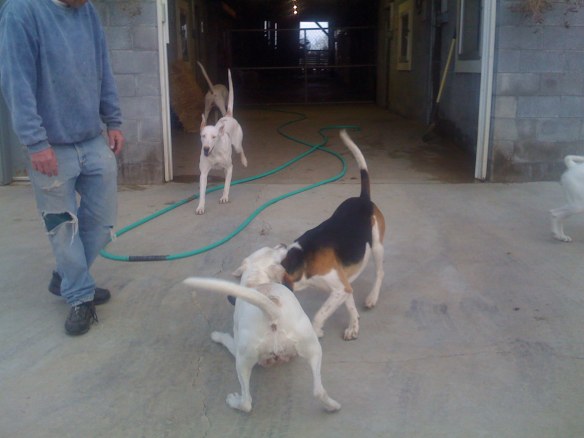
Paper (right) at play. Playing is an important part of learning.
While we were at the kennel, we checked in on the new English hounds, too. Cottesmore’s Samson, Strawberry, Structure, and Hawkeye arrived about three weeks ago and are adjusting well, Michael and Alan report. Like the puppies, they are having to learn their place in a new pack, and Michael and Alan are working to figure out which clique within the pack works best for them.
“I think a lot of their ability to adjust easily has to do with Neil,” Michael said, referring to the Cottesmore huntsman, Neil Coleman, who raised and hunted the four in England.
“Look at Samson over here,” Michael said, pointing to the group just turned out in the two-acre field. “He’s in there with all those males. They’re all at the age where they’re trying to show who’s top dog: Paper, Gaelic, Hailstone. But Samson’s the type you could probably stick him in any group and he’d adjust. Because he’s not aggressive. That has a lot to do with the way Neil has raised them. And the others are the same way.”
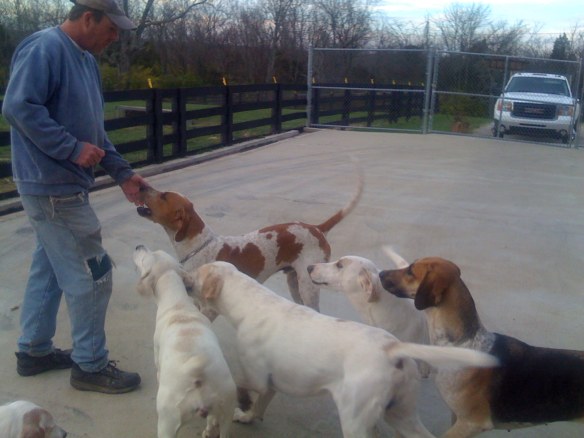
Cottesmore Samson, the red-and-white hound closest to Michael here, has settled in well. Michael and Alan report that he is easygoing and adaptable.
Structure, Hawkeye, and Strawberry are kenneled in a run with the SA litter that includes Sassoon, Savvy, and Saracen. “They’re pretty easygoing, too,” Michael said.
One of the most important jobs Michael and Alan do is figure out which group of hounds should be kenneled together. Getting the mix right requires some experimentation, but it’s key to the hounds’ physical and mental wellbeing; getting it wrong could result in dangerous friction in the kennel.
“When I brought the English hounds up from the lower kennel (near Michael’s house, where they were quarantined before joining the rest of the pack at the upper kennel), I just started sticking them out in the field with different groups to see how they responded to each other. When they’re outside together with a lot of room, they’re more interested in what’s going on around them than they are in each other, and you can keep an eye on them. I stuck them in with the SAs and never had any issues with them, so that looks like a good fit.”
The process–the two-acre turnout paddock and essentially letting the hounds choose the clique they’re most comfortable with–is unusual, as the English imports let Michael and Alan know.
“When we first turned them out, they all just stood at the gate looking at us like, ‘What’s going on?'” Michael recalled. “But after a few minutes, they sort of went, ‘Hey, look at all this room! Let’s run!'”
Once the hounds have chosen their own group of friends, how do you get each set to merge comfortably with the pack? “We turn different groups out together,” Michael explained. “There are only a few groups that have a little trouble mixing closely, and you have to know all that, especially when you are loading them up in the trailer to take them to a meet. For instance, we can keep some hounds in the back of the hound truck instead of in the trailer if we need to.”
It’s also critical to know who the dominant dog is at any given time, Michael said. At the moment, it’s Alvin.
“Stalker was the big dog before we retired him,” Michael said. Stalker, one of our most beloved hounds, is now retired under the care of the Hound Welfare Fund. You can read his story here. But now that he’s retired, he spends more time in the kennel office, where he can relax and keep warm, and suddenly he’s a mellow retiree.
“Showing his dominance doesn’t seem to concern him so much now,” Michael said. “I guess he’s old enough to realize he’s got it made in there!”




























































